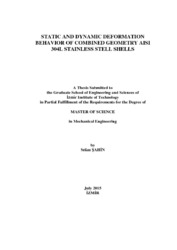Please use this identifier to cite or link to this item:
https://hdl.handle.net/11147/4336Full metadata record
| DC Field | Value | Language |
|---|---|---|
| dc.contributor.advisor | Taşdemirci, Alper | - |
| dc.contributor.advisor | Güden, Mustafa | - |
| dc.contributor.author | Şahin, Selim | - |
| dc.date.accessioned | 2015-11-20T09:24:37Z | |
| dc.date.available | 2015-11-20T09:24:37Z | |
| dc.date.issued | 2015-07 | - |
| dc.identifier.citation | Şahin, S. (2015). Static and dynamic deformation behavior of combined geometry AISI 304L stainless stell shells. Unpublished master's thesis, Izmir Institute of Technology, Izmir, Turkey | en_US |
| dc.identifier.uri | http://hdl.handle.net/11147/4336 | - |
| dc.description | Thesis (Master)--Izmir Institute of Technology, Mechanical Engineering, Izmir, 2015 | en_US |
| dc.description | Includes bibliographical references (leaves: 109-114) | en_US |
| dc.description | Text in English; Abstract: Turkish and English | en_US |
| dc.description | xiii, 114 leaves | en_US |
| dc.description.abstract | In this study, the static and dynamic crushing behavior of combined geometry shells consisting of hemi-spherical and cylindrical segments were studied both experimentally and numerically. The proposed geometries were manufactured by deep drawing. Due to the nature of the deep drawing process, specimens inherited significant amount of residual stress/strain and thickness variation along the cross-section was observed. Thus, the manufacturing process was also numerically modeled explicitly. Quasi-static compression and dynamic drop weight tests were conducted both experimentally and numerically. The plastic deformation of the combined geometry shells started with the inward dimpling of the hemi-spherical segment and progressively continued deforming with the asymmetric or axisymmetric folding in cylindrical segment depending on the radius to thickness ratios and strain rates. The failure/fracture was observed in the thicker specimens at dynamic strain rates and that caused decreases in specific absorbing energy (SAE) levels. In addition, the energy partitions between the hemi-spherical segments increased at higher loading rates. Furthermore, the inertia and rate sensitivity influenced the crushing response of cylindrical segment more than that of hemi-spherical segment and inertia effect was more pronounced than the rate sensitivity at higher loading rates. Considering the thermal effects in the crushing behavior of the combined geometry shells, it was shown that the mean crushing load lowered as the temperature increased. Additionally, the percentages of increase in the crushing load were limited at lower temperatures for varying loading rates. It was shown that as the absolute temperature increased the percentage of increase in crushing load was significantly increased due to the change in deformation mode. | en_US |
| dc.description.abstract | Bu çalışmada, yarı küresel ve silindirik geometriden meydana gelen kombine geometrili kabuk yapıların ezilme davranışları deneysel ve nümerik olarak incelenmiştir. Söz konusu geometriler derin çekme metodu kullanılarak elde edilmiştir. Derin çekme işleminin doğasından dolayı, numuneler üzerinde artık gerilme/gerinim ve kesit alanı boyunca kalınlık değişimi gözlemlenmiştir. Bu sebeple üretim prosesi de nümerik olarak ayrıca modellenmiştir. Statik ezilme ve dinamik düşen ağırlık testleri deneysel ve nümerik olarak gerçekleştirilmiştir. Kombine geometrili kabuk yapılar plastik deformasyonlarına yarı-küresel bölgelerinin içe doğru çukurlaşması ile başlamaktadır ve sonrasında yarıçapın kalınlığa oranına ve şekil değiştirme hızına bağlı olarak silindrik bölgelerinde asimetrik veya eksenel simetrik katlanma yaparak deformasyonunu sürdürmektedir. Dinamik şekil değiştirme hızlarında kalın numunelerin üzerinde kırılmalar görülmektedir ve bu numunelerin özgül enerji emme kapasitesinde azalmaya sebep olmaktadır. Buna ek olarak, numunelerin yarı-küresel bölgelerinin enerji emilimine katılımları yüksek yükleme hızlarında artmaktadır. Buna ek olarak, atalet ve şekil değiştirme hızı hassasiyetinin silindirik bölgelerin ezilme tepkilerine yarı-küresel bölgelere nazaran daha etkili olduğu görülmektedir ve yüksek deformasyon hızlarında atalet etkisinin şekil değiştirme hızı hassasiyetine göre daha baskın olduğu bulunmuştur. Sıcaklığın, kombine geometrili kabuk yapıların ezilme davranışlarına etkisi düşünüldüğünde, ortalama kuvvet değerinin sıcaklığın artması ile azaldığı görülmüştür. Ayrıca, ezilme kuvvetinin yüzdelik artışı düşük sıcaklık değerlerinde değişen yükleme hızları için sınırlıdır. Mutlak sıcaklığın artması ile ezilme kuvvetinin yüzdelik artışı deformasyon modunun değişmesinden dolayı önemli ölçüde artmaktadır. | en_US |
| dc.description.sponsorship | TÜBİTAK project 112M141 | en_US |
| dc.language.iso | en | en_US |
| dc.publisher | Izmir Institute of Technology | en_US |
| dc.rights | info:eu-repo/semantics/openAccess | en_US |
| dc.subject | Combined geometry shells | en_US |
| dc.subject | Crushing behavior | en_US |
| dc.subject | Finite element method | en_US |
| dc.subject.lcsh | Stainless steel--Testing | en_US |
| dc.subject.lcsh | Shells (Engineering) | en_US |
| dc.subject.lcsh | Materials--Dynamic testing | en_US |
| dc.subject.lcsh | Statics | en_US |
| dc.title | Static and Dynamic Deformation Behavior of Combined Geometry Aisi 304l Stainless Stell Shells | en_US |
| dc.title.alternative | Birleşik Geometrili Aısı 304l Paslanmaz Çelik Kabuk Yapıların Statik ve Dinamik Davranışları | en_US |
| dc.type | Master Thesis | en_US |
| dc.institutionauthor | Şahin, Selim | - |
| dc.department | Thesis (Master)--İzmir Institute of Technology, Mechanical Engineering | en_US |
| dc.relation.publicationcategory | Tez | en_US |
| dc.identifier.wosquality | N/A | - |
| dc.identifier.scopusquality | N/A | - |
| item.openairecristype | http://purl.org/coar/resource_type/c_18cf | - |
| item.languageiso639-1 | en | - |
| item.openairetype | Master Thesis | - |
| item.grantfulltext | open | - |
| item.fulltext | With Fulltext | - |
| item.cerifentitytype | Publications | - |
| Appears in Collections: | Master Degree / Yüksek Lisans Tezleri | |
Files in This Item:
| File | Description | Size | Format | |
|---|---|---|---|---|
| T001353.pdf | MasterThesis | 7.88 MB | Adobe PDF |  View/Open |
CORE Recommender
Page view(s)
262
checked on Mar 31, 2025
Download(s)
186
checked on Mar 31, 2025
Google ScholarTM
Check
Items in GCRIS Repository are protected by copyright, with all rights reserved, unless otherwise indicated.